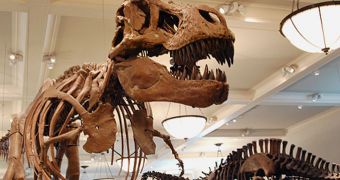Dinosaurs were the ultimate rulers of our planet for many millions of years, particularly within a time span stretching from 200 million years ago to roughly 65 million years ago. Marked by two catastrophic extinction events, the time of the dinosaurs is divided in the Triassic, Jurassic and Cretaceous periods, and experts have always wondered how it was that the giant lizards came to power in the inhospitable world following the Permian–Triassic (P–Tr) extinction event, also known as the Great Dying. Now, a series of new studies paint a more complex picture of what happened.
As the world was settling from the effects of the most recent extinction event, the life forms that survived the catastrophic event were clogged on a single super-continent, centered roughly on the Equator, and called Pangaea. At the time, North America was just beginning the process of ripping itself apart from North Africa, and vast amounts of magma were pouring out of the world, producing accumulations of lava that could easily cover the entire surface of the continental United States at this point in time. Intuitively, life was in a pretty pickle, considering that solidified lava is a barren landscape that provides little things in terms of nourishment. However, dinosaurs thrived, LiveScience reports.
“The big thing is many people have heard why dinosaurs went extinct. But the question 'Why they came to be' is much more exciting,” Brown University in Rhode Island Assistant Professor of Geological Sciences and paleontologist Jessica Whiteside says. She has also been a researcher on the new study, details of which appear in this week's issue of the respected publication Proceedings of the National Academy of Sciences (PNAS), LiveScience reports. A large part of the conclusions in the research are not based directly on the fossilized bony remains of the animals, but on what experts term their “chemical fossils.”
Using this method, the team learned that a large variety of plants appeared after the two continents started separating. Their conclusion was based on the analysis of two types of carbon isotopes, one of which was produced by the magma that began to pour to the surface when the super-continent started breaking apart. Speaking about how the other reptiles and plants might have died, the expert says that, “Changes to the pH of the oceans, which killed most of the animals that make shells, and this greenhouse warming would likely have decimated many of the reptiles, including dinosaurs' main competitors.”
With no real competition to fight off, the earliest meat-eating dinosaurs, including the famous Tyrannosaurus Rex and the Velociraptor, started developing, and eventually got hold of their environment. “It's really that it was just a fortuitous combination of traits that they unwittingly possessed that let them get through the catastrophic climate change that their competitors didn't have,” Whiteside says of the reasons why these giant lizards endured when other animals didn't.

 14 DAY TRIAL //
14 DAY TRIAL //